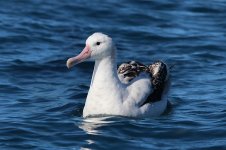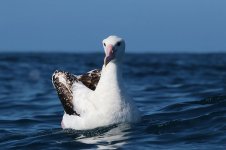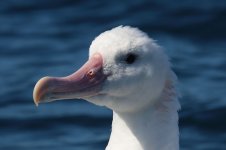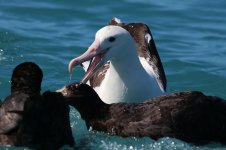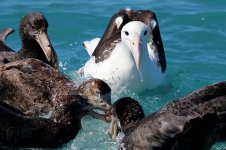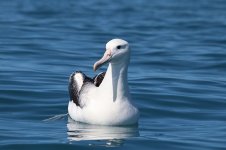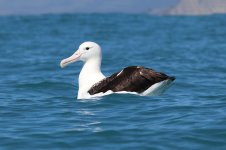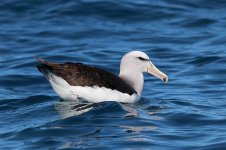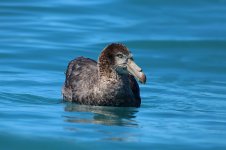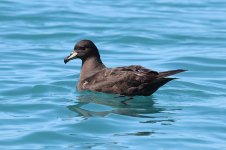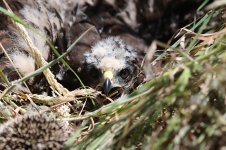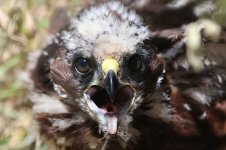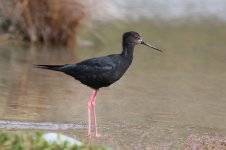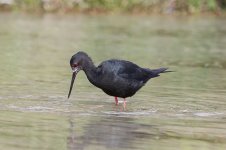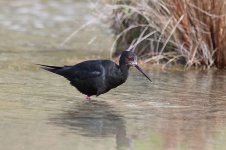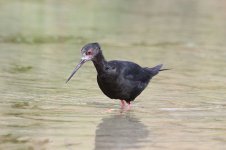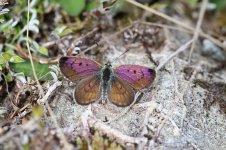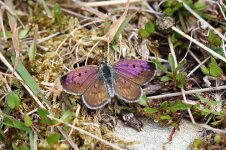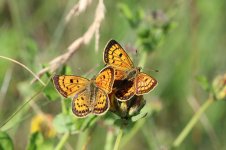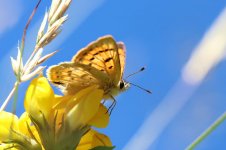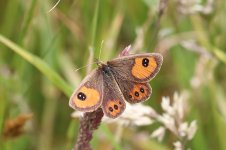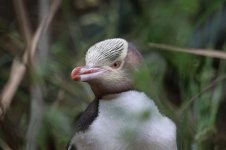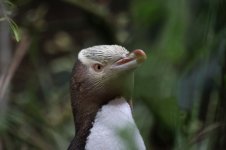
23 December. North Island-South Island.
Ferry day between North Island and South Island, but first a little time to savour the delights of Otaki Sewage Pools. Heaps of birds here, hundreds of Paradise Shelducks, 135 Australasian Shovelers, one New Zealand Little Grebe and oodles of other waterbirds, but also one special species - the main reason for my visit, and not too difficult to find, one smart Black-fronted Dotterel trotting along the water's edge. This was a welcome bird indeed, and it would be the only one I would see on my trip.
With that, it was down to Wellington to await the ferry. Departed under grey skies, already a Fluttering Shearwater or two milling in the bay, White-fronted Terns patrolling the coastline. Not much to report for the first half hour or so as we chugged out through Wellington Harbour, but then we hit the open waters of Cook Strait, now in full sunshine and with a nice southern swell running. And from then on, for the ninety minutes in Cook Strait, birds galore – my first albatrosses of the trip (several White-capped Albatrosses, one Gibson's Wandering Albatross, three Southern Royal Albatrosses), plus well over 100 Fairy Prions, often right up against the ferry, as well as numerous Buller's Shearwaters riding the considerable waves. As my first ever venture into New Zealand waters, identification was a bit challenging to say and quite a few more distant birds sailed by without names, but in amongst the above and numerous Fluttering Shearwaters, did pick out at least two Westland Petrels, one Sooty Shearwater and, rather easier, three Arctic Skuas.
All too soon, we entered the sheltered waters of Marlborough Sound, signalling an almost immediate halt to most of the seabirds, though Fluttering Shearwaters remained abundant right up to Picton, along with lesser numbers of Australasian Gannets and plenty of White-fronted Terns. Had hoped to fluke a New Zealand King Shag, but that really would have been lucky. Had to settle for several Pied Cormorants instead.
And so I was now on South Island, part two of my New Zealand adventure beginning. Scheduled for a boat trip from Kaikoura next morning, I immediately headed south, sufficient time for two stops on route - Blenheim Sewage Pools and Elterwater. Effectively twitching local rarities at both, my targets fell with ease - Glossy Ibis at Blenheim (a pair breeding in a bustling colony of Royal Spoonbills), then three cracking Hoary-headed Grebes at Elterwater (a rare vagrant from Australia, though breeders at this site).
I continued to within a few kilometres of Kaikoura, then headed inland to a quaint campsite surrounded by native bushland, sounds of Tui and Morepork ringing out as I pitched my tent.
Ferry day between North Island and South Island, but first a little time to savour the delights of Otaki Sewage Pools. Heaps of birds here, hundreds of Paradise Shelducks, 135 Australasian Shovelers, one New Zealand Little Grebe and oodles of other waterbirds, but also one special species - the main reason for my visit, and not too difficult to find, one smart Black-fronted Dotterel trotting along the water's edge. This was a welcome bird indeed, and it would be the only one I would see on my trip.
With that, it was down to Wellington to await the ferry. Departed under grey skies, already a Fluttering Shearwater or two milling in the bay, White-fronted Terns patrolling the coastline. Not much to report for the first half hour or so as we chugged out through Wellington Harbour, but then we hit the open waters of Cook Strait, now in full sunshine and with a nice southern swell running. And from then on, for the ninety minutes in Cook Strait, birds galore – my first albatrosses of the trip (several White-capped Albatrosses, one Gibson's Wandering Albatross, three Southern Royal Albatrosses), plus well over 100 Fairy Prions, often right up against the ferry, as well as numerous Buller's Shearwaters riding the considerable waves. As my first ever venture into New Zealand waters, identification was a bit challenging to say and quite a few more distant birds sailed by without names, but in amongst the above and numerous Fluttering Shearwaters, did pick out at least two Westland Petrels, one Sooty Shearwater and, rather easier, three Arctic Skuas.
All too soon, we entered the sheltered waters of Marlborough Sound, signalling an almost immediate halt to most of the seabirds, though Fluttering Shearwaters remained abundant right up to Picton, along with lesser numbers of Australasian Gannets and plenty of White-fronted Terns. Had hoped to fluke a New Zealand King Shag, but that really would have been lucky. Had to settle for several Pied Cormorants instead.
And so I was now on South Island, part two of my New Zealand adventure beginning. Scheduled for a boat trip from Kaikoura next morning, I immediately headed south, sufficient time for two stops on route - Blenheim Sewage Pools and Elterwater. Effectively twitching local rarities at both, my targets fell with ease - Glossy Ibis at Blenheim (a pair breeding in a bustling colony of Royal Spoonbills), then three cracking Hoary-headed Grebes at Elterwater (a rare vagrant from Australia, though breeders at this site).
I continued to within a few kilometres of Kaikoura, then headed inland to a quaint campsite surrounded by native bushland, sounds of Tui and Morepork ringing out as I pitched my tent.





